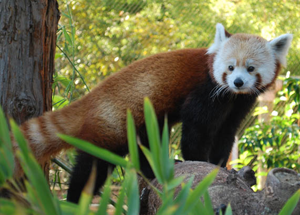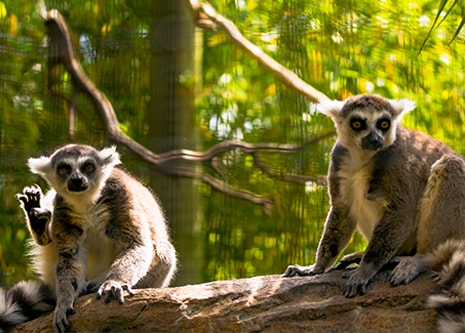
- VisitSupport Happy HollowDONATE TODAYExploreSupport Happy HollowDONATE TODAYLearnSupport Happy HollowDONATE TODAYSupport
-
Today's Hours: 10:00 am to 5:00 pm
Zoo in the HollowRed panda

Scientific name: Ailurus fulgens
Family: Ailuridae
Order: Carnivora
Class: Mammalia
Range: Himalayas, Nepal, India, Bhutan, Myanmar, and China
Habitat: Temperate Forest
Lifespan: 8 to 10 years in the wild; up to 15 years in captivityWhat do they look like?
The red panda has striking features, with white markings on the muzzle, face, and ears and a bushy ringed tail. Of the two sub-species, one has more white covering its face than the other. The top portion of their body is covered in red fur while their underbelly and legs are covered in black fur. Their thick fur covers the soles of their feet to help regulate their body heat in the snow. Their entire body length can be between 30 to 45 inches. This includes their long tail, used for balance, which can range from 12 to 20 inches. Red pandas can weigh between six to 14 pounds, with females generally being slightly smaller than males.How do they behave?
Red pandas are typically solitary animals and territorial, coming together in groups only during breeding season. They are also arboreal (spending almost all of their time in trees). Red pandas are crepuscular (mostly active at dawn and dusk), but can also be nocturnal (mostly active at night) to avoid extremely warm temperatures. They spend most of their time foraging for food and eating bamboo. Red pandas can be found stretched out on a branch to cool down in warmer weather or curled up in a ball with their tail covering their face in colder weather.What do they eat?
Bamboo is the main source of food for the red panda; however, it does not provide enough nutrition unless eaten in very large quantities. Red pandas will consume about 30% of their body weight in bamboo daily, focusing on the young leaves and shoots. To supplement their diet, they may also eat fruit, grasses, acorns, insects, eggs, fish and small animals. At Happy Hollow, they eat specialized leaf eater biscuits, fruit and lots of fresh bamboo grown at Happy Hollow.How are they born?
Breeding season for red pandas is dependent on the photoperiod (daily exposure to light) increasing, January through March in the northern hemisphere and June through August in the southern hemisphere. After courtship and breeding, the female red panda will begin nesting. She will find a spot in a tree or rock crevice and build a nest, much like a bird. Gestation on average takes 135 days. The mother typically gives birth to two cubs that are blind and deaf. Cubs are weaned between 13 to 22 weeks and reach sexual maturity around 18 months of age. Cubs can stay with their mother for up to a year, and are usually sent out on their own when they reach sexual maturity or when their mother is ready to breed again.Conservation
The conservation status of red pandas is listed as Endangered by the International Union for Conservation of Nature . One of the main threats to these pandas is habitat loss. Red pandas live in mountainous temperate forests, therefore, helping them means helping their habitat! One organization working to protect red pandas and their habitat is the Red Panda Network. Through the Red Panda Network, kids can become red panda rangers, and adults can adopt a wild red panda or sponsor a forest guardian. If you would like to participate in red panda conservation, visit the Red Panda Network at www.redpandanetwork.org for more details.
Zoo on the Hill
Located across from the Keep-Around Carousel is the Zoo on the Hill. Learn about wildlife up close during daily meet-and-greets, leap like a lemur on the playground, brush and feed the goats,, or take a peek inside Doc’s Critter Care building and the Ranch House. Double-H Ranch features a combination of animal exhibits, including giant anteaters and red ruffed lemurs, as well chickens and domesticated animals that are docile enough to touch.
See Animals
Education Ambassadors
From camps and classes to scout badges and sleepovers, Happy Hollow education programs have something for everyone! The zoo education program offers a broad range of hands-on, engaging programs and public presentations featuring education ambassador animals. These encounters are designed to connect you to wildlife and the conservation of their habitats around the world.
See AnimalsVisit Us Today
Plan an unforgettable experience at San Jose’s family-friendly park and zoo.
Learn More